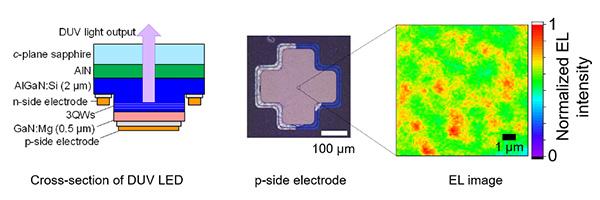Faster LEDs for wireless communications from invisible light

Researchers aimed to improve LEDs that specifically communicate via deep ultraviolet light, which isn't visible to the human eye. Credit: Kazunobu Kojima, Tohoku University
Now, a team of researchers based in Japan has married the two options into the ideal combination of long lasting and fast LEDs. They published their results on July 22 in Applied Physics Letters.
“A key technology for faster modulation is to decrease the device si earch for Advanced Materials at Tohoku University. “However, this tactic creates a dilemma: although smaller LEDs can be modulated faster, they have lower power.”
Another issue is that both visible and infrared optical wireless communications can have significant solar interference, according to Kojima. To avoid confusion with visible and infrared solar light, the researchers aimed to improve LEDs that specifically communicate via deep ultraviolet light, which can be detected without solar interference.
“Deep ultraviolet LEDs are currently mass produced in factories for applications related to COVID-19,” Kojima said, noting that deep ultraviolet light is used for sterilization processes as well as in solar-blind optical wireless communications. “So, they're cheap and practical to use.”
The researchers fabricated the deep ultraviolet LEDs on sapphire templates, which are considered an inexpensive substrate, and measured their transmission speed. They found that the deep ultraviolet LEDs were smaller and much quicker in their communications than traditional LEDs at that speed.
“The mechanism underlying this speed is in how a lot of tiny LEDs self-organize in a single deep ultraviolet LED,” Kojima said. “The tiny LED ensemble helps with both power and speed.”
The researchers want to use the deep ultraviolet LEDs in 5G wireless networks. Many technologies are currently under testing to contribute 5G, and Li-Fi, or light fidelity, is one of the candidate technologies.
“Li-Fi's critical weakness is its solar dependency,” Kojima said. “Our deep ultraviolet LED-based optical wireless technology can compensate for this problem and contribute to society, I hope.”
###
This work was supported in part by Five-Star Alliance and the Japan Society for the Promotion of Science.
Media Contact
All latest news from the category: Information Technology
Here you can find a summary of innovations in the fields of information and data processing and up-to-date developments on IT equipment and hardware.
This area covers topics such as IT services, IT architectures, IT management and telecommunications.
Newest articles

Combatting disruptive ‘noise’ in quantum communication
In a significant milestone for quantum communication technology, an experiment has demonstrated how networks can be leveraged to combat disruptive ‘noise’ in quantum communications. The international effort led by researchers…

Stretchable quantum dot display
Intrinsically stretchable quantum dot-based light-emitting diodes achieved record-breaking performance. A team of South Korean scientists led by Professor KIM Dae-Hyeong of the Center for Nanoparticle Research within the Institute for…

Internet can achieve quantum speed with light saved as sound
Researchers at the University of Copenhagen’s Niels Bohr Institute have developed a new way to create quantum memory: A small drum can store data sent with light in its sonic…





















